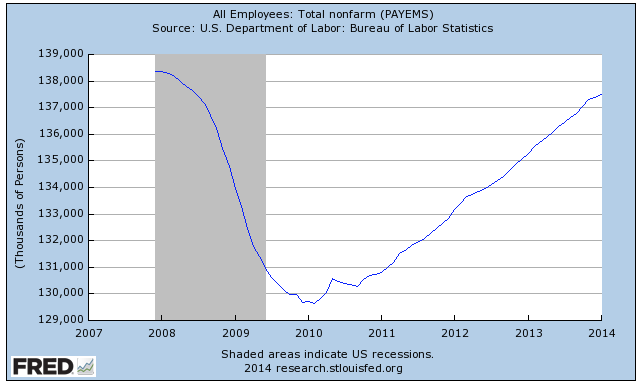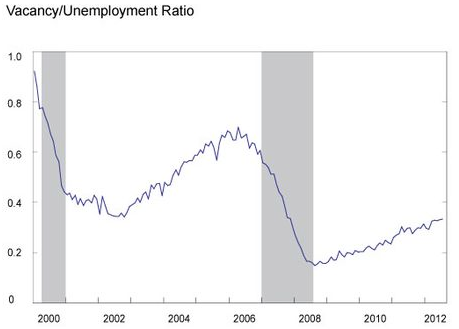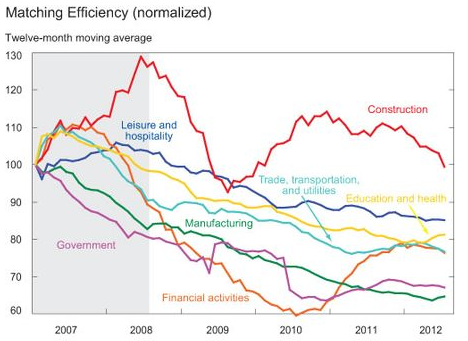The Federal Reserve has now been "pumping and dumping" since September 2008, it's interesting to see that $3.24 trillion worth of unconventional policy has left America's employment situation in relatively poor shape, even with the decline in the headline U-3 numbers.
According to researchers at the Federal Reserve Bank of New York, jobs that were lost during the Great Recession have nearly been replaced as you can see on this graph:
At the beginning of the recession in December 2007, there were 138.35 million non-farm workers, dropping to a low of 129.665 million in February 2010, a loss of 8.685 million non-farm jobs. Since then, the number of non-farm workers has risen to the January 2014 level of 137.499 million, still 900,000 short of the pre-recession level but still a fairly reasonable improvement unless one considers the new entrants into the job market who have fewer jobs to compete for.
While the number of jobs is an important measure, an even more important indicator is the job-finding rate which is defined as the fraction of unemployed workers in a given month that find employment in the following month. This is a good indicator of how easy it is to find a job in the economy. Job finding rates vary between zero (no unemployed workers found a job in the following month) to 1.0 (all unemployed workers found a job in the following month) with gradations in between. Basically, the higher the fraction, the better the job market.
Here is a graph showing the job-finding rate since 1990:
Notice that between recessions (shaded grey), the job finding rate rises. At its nadir, the job-finding rate never dipped below 0.23 after the 1991 and 2001 recessions, meaning that 23 percent of unemployed workers found work in the following month. In the inter-recessional periods, the job-finding rate gradually rises, hitting a level of around or slightly above 0.3. In the case of the current recession, the job-finding rate dipped to 0.17 and has just recovered to 0.2, a level that is still below the lowest levels seen after the two previous recessions.
Economists have developed a theory about job searching and matching. It is costly for both firms and individuals to form suitable matches because the labor markets are not co-ordinated. Workers devote substantial time to job-finding including writing and sending out resumes and interviewing and firms use resources to post vacant jobs and interview candidates. The process that matches workers to firms can be defined by the matching function which looks like this:
Where v/u is the ratio of job vacancies to the number of unemployed, x is the matching efficiency and a is elasticity.
Here is a graph showing the job vacancy-to-unemployment ratio (v/u):
Where the ratio is high, there are many job openings per unemployed individual, making it easier to find a job and vice versa. Notice that this ratio is still below levels seen during the low point and has recovered much more slowly than it did after the recession at the beginning of the new millennium.
Here is a graph showing matching efficiency (x):
The matching efficiency captures factors that affect the efficiency of the matching process between unemployed workers and job openings. These factors include
1.) skill
2.) geographic location
3.) changes in recruitment levels by employers
4.) changes in search efforts by unemployed workers
The graph shows that the matching efficiency declined substantially during the Great Recession and has basically not recovered since. This means that it is more difficult for America's unemployed workers to match themselves with job openings for a combination of the reasons noted above.
Here is a chart showing the matching efficiencies for several key sectors of the economy since the beginning of the Great Recession:
Note that the only sector that has shown a return to pre-Great Recession levels job matching efficiency is, surprisingly, the construction sector.
The authors conclude that the biggest problem interfering with the American job market is the low job vacancy-to-unemployment ratio, in other words, the low number of job openings. With the accompanying decline in matching efficiency for most sectors of the economy, it could be some time before the plight of America's long-term unemployed improves…unless, of course, the Federal Reserve is willing to create internal jobs for a few million Americans!
Click HERE to read more of Glen Asher's columns
You can publish this article on your website as long as you provide a link back to this page.







Be the first to comment